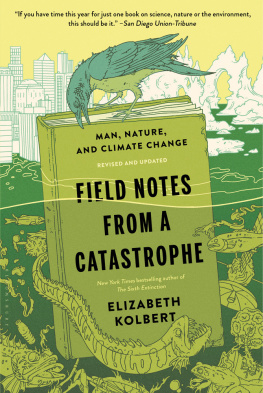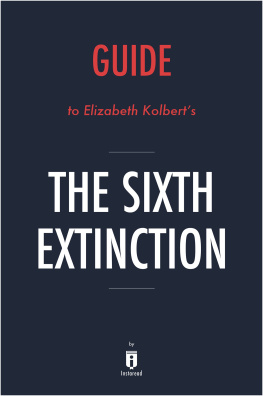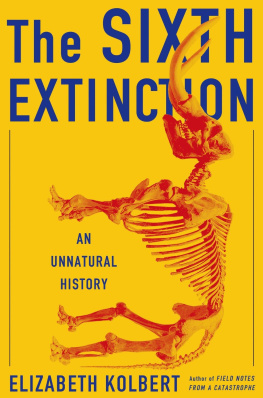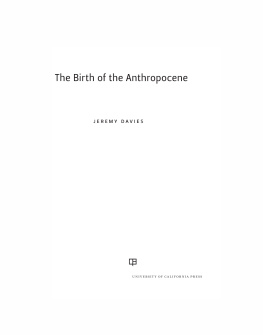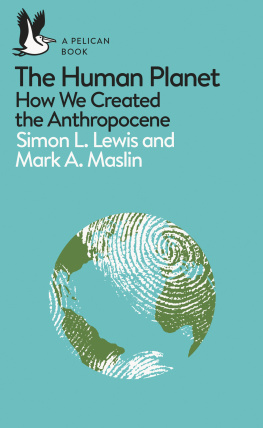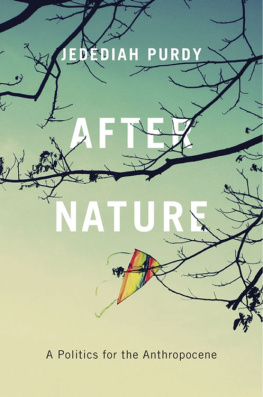Maps and graphics 2021 MGMT. Design
All rights reserved.
Published in the United States by Crown, an imprint of Random House, a division of Penguin Random House LLC, New York.
Crown and the Crown colophon are registered trademarks of Penguin Random House LLC.
Names: Kolbert, Elizabeth, author.
Title: Under a white sky / Elizabeth Kolbert.
Description: First edition. | New York: Crown, [2021] | Includes bibliographical references and index.
Identifiers: LCCN 2020047398 (print) | LCCN 2020047399 (ebook) | ISBN 9780593136270 (hardcover) | ISBN 9780593238776 | ISBN 9780593136294 (ebook)
Subjects: LCSH: NatureEffect of human beings on. | Human ecology. | Environmental protection. | Ecological engineering. | Sustainability.
Sometimes he runs his hammer along the walls, as though to give the signal to the great waiting machinery of rescue to swing into operation. It will not happen exactly in this waythe rescue will begin in its own time, irrespective of the hammerbut it remains something, something palpable and graspable, a token, something one can kiss, as one cannot kiss rescue.
1
Rivers make good metaphorstoo good, perhaps. They can be murky and charged with hidden meaning, like the Mississippi, which to Twain represented the grimmest and most dead-earnest of reading matter. Alternatively, they can be bright and clear and mirror-like. Thoreau set off for a week on the Concord and Merrimack Rivers and within a day found himself lost in reflection over the reflections he saw playing on the water. Rivers can signify destiny, or coming into knowledge, or coming upon that which one would rather not know. Going up that river was like traveling back to the earliest beginnings of the world, when vegetation rioted on the earth, Conrads Marlow recalls. They can stand for time, for change, and for life itself. You cant step into the same river twice, Heraclitus is supposed to have said, to which one of his followers, Cratylus, is supposed to have replied, You cant step into the same river even once.
It is a bright morning following several days of rain, and the not-quite-river I am riding is the Chicago Sanitary and Ship Canal. The canal is a hundred and sixty feet wide and runs as straight as a ruler. Its waters, the shade of old cardboard, are flecked with candy wrappers and bits of Styrofoam. On this particular morning, traffic consists of barges hauling sand, gravel, and petrochemicals. The one exception is the vessel Im on, a pleasure craft named City Living.
City Living is outfitted with off-white banquettes and a canvas awning that snaps smartly in the breeze. Also on board are the boats captain and owner and several members of a group called Friends of the Chicago River. The Friends are not a fastidious bunch. Often their outings involve wading knee-deep in polluted water to test for fecal coliform. Still, our expedition is slated to take us farther down the canal than any of them has ever been before. Everyone is excited and, if truth be told, also a little creeped out.
We have made our way into the canal from Lake Michigan, via the Chicago Rivers South Branch, and now are motoring west, past mountains of road salt, mesas of scrap metal, moraines of rusted shipping containers. Just beyond the city limits, we skirt the outflow pipes of the Stickney plant, said to be the largest sewage operation in the world. From the deck of City Living, we cant see the Stickney, but we can smell it. Conversation turns to the recent rains. These have overwhelmed the regions water-treatment system, resulting in combined sewer overflows, or CSOs. There is speculation about what sort of floatables the CSOs have set adrift. Someone wonders if well encounter any Chicago River whitefish, local slang for used condoms. We chug on. Eventually, the Sanitary and Ship Canal joins up with another canal, known as the Cal-Sag. At the meeting of the waters, theres a V-shaped park, featuring picturesque waterfalls. Like just about everything else on our route, the waterfalls are manufactured.
If Chicago is the City of the Big Shoulders, the Sanitary and Ship Canal might be thought of as its Oversized Sphincter. Before it was dug, all of the citys wastethe human excrement, the cow manure, the sheep dung, the rotting viscera from the stockyardsran into the Chicago River, which, in some spots, was so thick with filth it was said a chicken could walk from one bank to the other without getting her feet wet. From the river, the muck flowed into Lake Michigan. The lake wasand remainsthe citys sole source of drinking water. Typhoid and cholera outbreaks were routine.
The canal, which was planned in the closing years of the nineteenth century and opened at the start of the twentieth, flipped the river on its head. It compelled the Chicago to change its direction, so that instead of draining into Lake Michigan, the citys ordure would flow away from it, into the Des Plaines River, and from there into the Illinois, the Mississippi, and, ultimately, the Gulf of Mexico. Water in Chicago River Now Resembles Liquid, ran the headline in The New York Times.
The reversal of the Chicago was the biggest public-works project of its time, a textbook example of what used to be called, without irony, the control of nature. Excavating the canal took seven years and entailed the invention of a whole new suite of technologiesthe Mason & Hoover Conveyor, the Heidenreich Inclinewhich, together, became known as the Chicago School of Earth Moving. In total, forty-three million cubic yards of rock and soil were gouged out, enough, one admiring commentator calculated, to build an island more than fifty feet high and a mile square. The river made the city, and the city remade the river.
But reversing the Chicago didnt just flush waste toward St. Louis. It also upended the hydrology of roughly two-thirds of the United States. This had ecological consequences, which had financial consequences, which, in turn, forced a whole new round of interventions on the backward-flowing river. It is toward these that City Living is cruising. Were approaching cautiously, though maybe not cautiously enough, because at one point City Living almost gets squished between two double-wide barges. The deckhands yell down instructions that are initially incomprehensible, then become unprintable.
About thirty miles up the down riveror is it down the up river?we draw near our goal. The first sign that were getting close is a sign. Its the size of a billboard and the color of a plastic lemon. Warning, it says. No Swimming, Diving, Fishing, or Mooring. Almost immediately theres another sign, in white: Supervise All Passengers, Children, and Pets. Several hundred yards farther along, a third sign appears, maraschino red. Danger, it states. Entering Electric Fish Barriers. High Risk of Electric Shock.
Everyone pulls out a cell phone or a camera. We photograph the water, the warning signs, and each other. Theres joking on board that one of us should dive into the river electric, or at least stick a hand in to see what happens. Six great blue herons, hoping for an easy dinner, have gathered, wing to wing, on the bank, like students waiting on line in a cafeteria. We photograph them, too.



